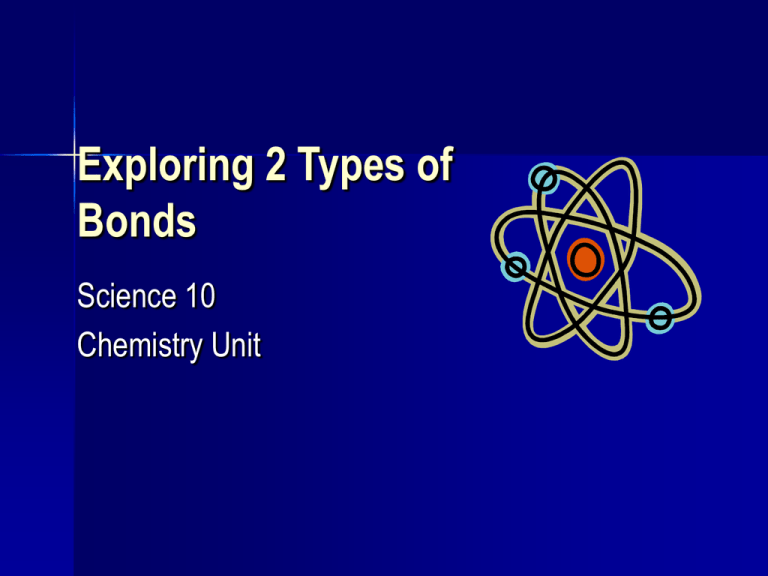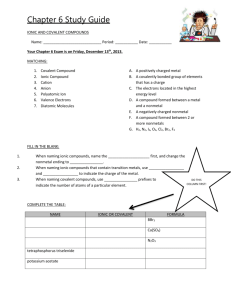ionic bonds
advertisement

Exploring 2 Types of Bonds Science 10 Chemistry Unit There are 2 types of bonds: 1. Ionic bonds 2. Covalent (or molecular) bonds Ionic Bonds Ionic bonds are formed when one or more electrons are transferred from one atom to another atom. This produces positively and negatively charged particles called ions. The forces of attraction that bind oppositely charged ions together are called ionic bonds. Ionic bonds generally occur between metals and nonmetals (cations and anions). Anions and cations are held together in an ionic bond due to electrostatic forces --oppositely charged “force fields” resulting from the oppositely charged ions. Examples: 1. NaCl 2. Fe2O3 3. BaF2 Covalent Bonding: Involves the “sharing” of electrons. It involves the bonds formed between a nonmetal and a non-metal (or metalloid). Important: Since these bonding non-metals (or metalloids) wish to gain electrons to become like a noble gas, and they can’t gain electrons from each other at the same time, they must share their electrons so they can both become like a noble gas. These compounds or molecules that are formed are neutral…they have no charge. Examples 1. H2O (water) 2. CO2 (carbon dioxide) 3. O2 (oxygen) Nomenclature: Different classes of compounds have different rules for naming. Before naming a compound, it is important to check which class it belongs to so that you will use the appropriate set of rules. Rules for Naming Binary Molecular Compounds To use this set of rules, the compound must be a molecular or covalent compound. In other words, it must be a non-metal + a non-metal (or metalloid) compound Rules: Name the first element as the name you see on your periodic table. Name the second element as you see it in your “Periodic Table of Ions”…the 2nd element always ends in “-ide” Use numerical prefixes to show how many of each atom is present in the molecule. Mono- is frequently or often, omitted. Write these on the “file cards” then place them in your plastic sheath. Prefix MonoDiTriTetraPentaHexaHeptaOctaNonaDeca- Number of Atoms in Compound 1 2 3 4 5 6 7 8 9 10 Naming Binary Molecular Compounds Write the names of the following covalent compounds: Sulphur trioxide 1. SO3 _______________________________________ Dinitrogen monosulfide 2. N2S _______________________________________ Phosphorous trihydride 3. PH3 _______________________________________ Boron trifluoride 4. BF3 _______________________________________ Diphosphorous tetrabromide 5. P2Br4 ______________________________________ 6. 7. 8. 9. 10. Carbon monoxide CO ________________________________________ silicon dioxide SiO2 _______________________________________ Sulphur hexafluoride SF6 _______________________________________ Nitrogen trihydride or Ammonia NH3 _______________________________________ nitrogen dioxide NO2 ________________________________________ Formula Writing of Binary Molecular Compounds NCl3 1. nitrogen trichloride ________________________ BC 2. boron monocarbide __________________________ N2O3 3. dinitrogen trioxide ________________________ PF5 4. phosphorus pentafluoride __________________ CH4 5. methane ______________________________ SBr2 6. sulfur dibromide _________________________ B2H4 7. diboron tetrahydride ______________________ OF2 8. oxygen difluoride _________________________ 9. CS2 carbon disulfide __________________________






